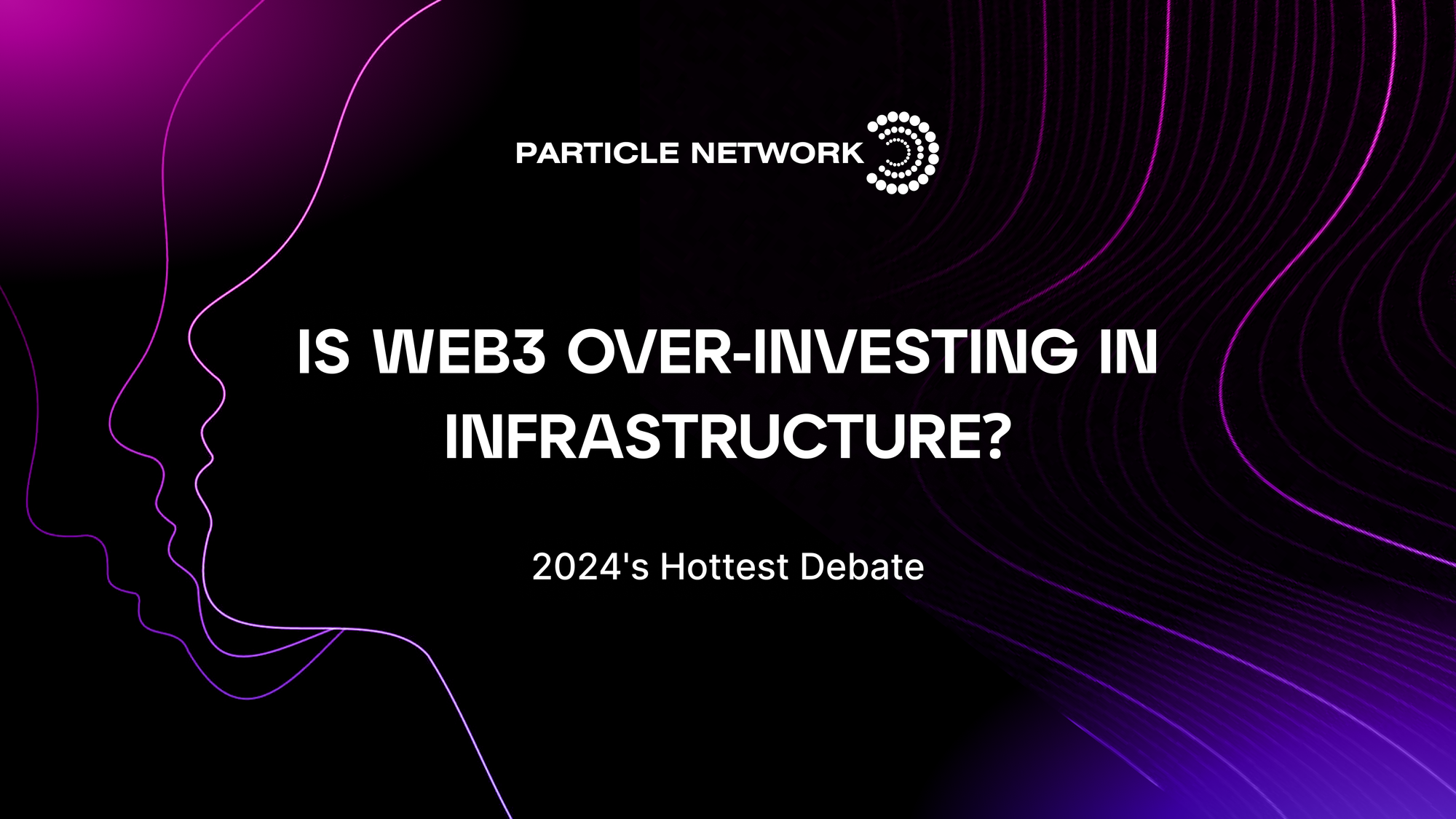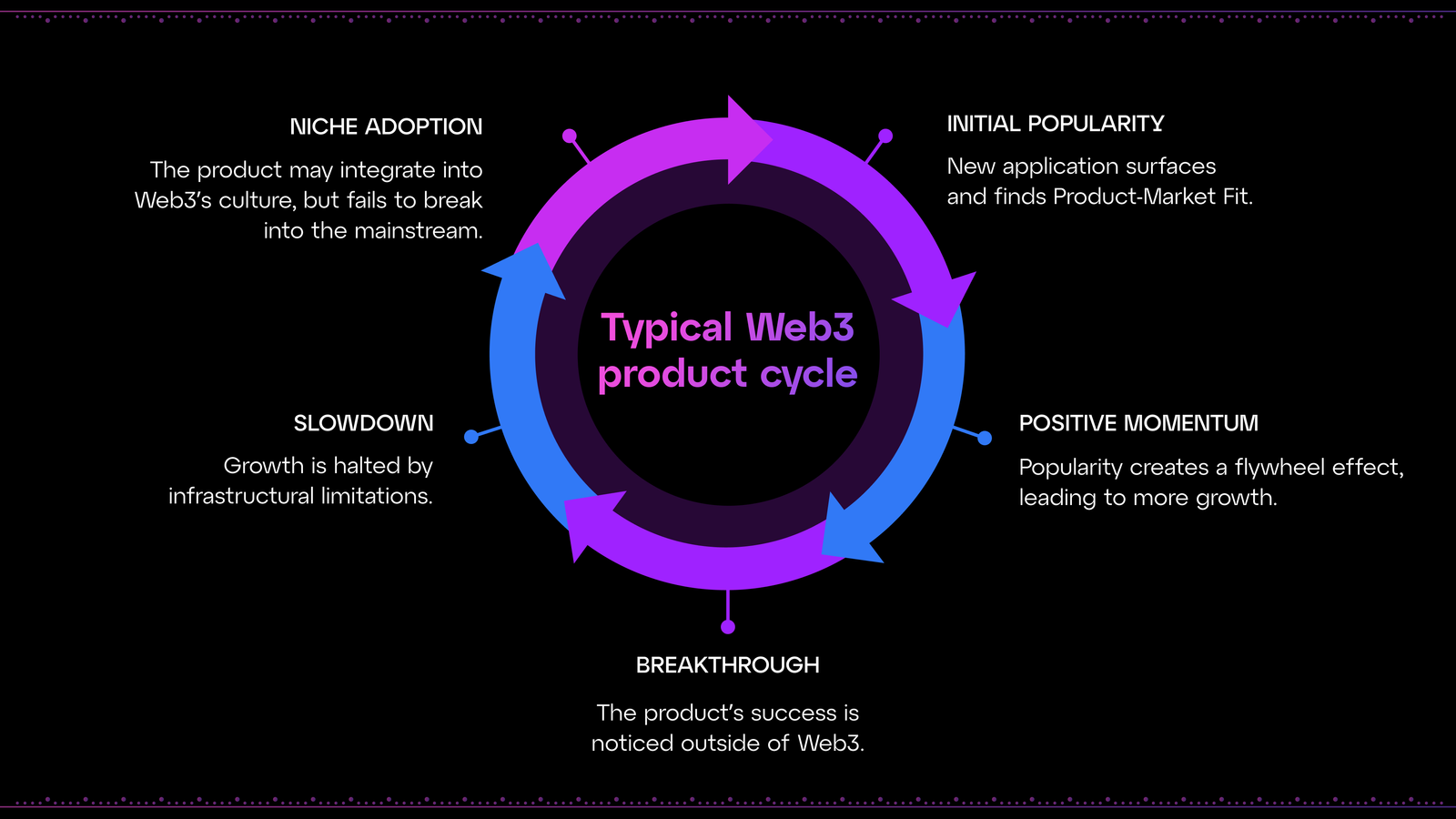Is Web3 Over-Investing In Infrastructure? Diving Into 2024’s Hottest Debate

Table of Contents:
There is an ongoing discussion across Web3 regarding where development efforts and resources should be focused.
There are two sides to it:
- The “we need to focus on rolling out dApps ready for mass adoption” camp. This group claims Web3 should work (and invest) harder on releasing decentralized applications that can be steadily adopted by non-Web3 users—something covered in our crypto predictions article.
People here tend to argue that, for blockchain technology to be considered valuable at a wide scale, it should first prove its worth by creating mass-consumption-ready products.
- The “we still haven’t built the infrastructure a robust Web3 needs” side, which argues that the ecosystem isn’t infrastructurally complete or ready for the mass market—and, as such, it’s unrealistic to expect dApps to be widely adopted yet.
This camp tends to point out that Web3 has seen glimpses of build-ups towards mass adoption, only for these to be abruptly stopped by the underlying system supporting them. It also argues that, in its current state, this infrastructure creates too many complexities for end-users, making mass adoption unviable.
As we’ll explore in this article, both angles are right in their own way. However, it’s also interesting to examine whether both positions necessarily clash, or whether there is a middle ground that can be closer to the truth.
Is this debate a false dichotomy?
Since it’s undeniable that high-quality dApps are needed for Web3 to succeed, we need to focus on what’s stopping their emergence. Let’s examine both sides’ arguments a bit closer here.
The “we need to focus on rolling out dApps ready for mass adoption” camp tends to attach reasons beyond infrastructural limitations to explain this.
Such reasons may be:
- Misaligned incentives, leading to most of the industry’s funding flowing into infrastructure solutions, as well as top talent withdrawing from dApp development.
- Lack of creativity to utilize blockchain technology towards true innovation.
- Lack of resources devoted to non-financial products.
- A lack of users who want to adopt early-stage, truly disruptive dApps.
On the flipside, the camp arguing Web3’s infrastructure is still incomplete may instead attribute Web3’s lacking adoption to the fact that:
- Currently, users are siloed across various chains due to Web3 fragmentation, making it harder for them to make the most out of the entire ecosystem.
- Similarly, this fragmentation creates an environment where dApps can circumvent competition by catering exclusively to siloed ecosystems, resulting in an ecosystem-wide lack of creativity and innovation.
- Fragmentation also results in a high cognitive barrier for new users to access Web3.
- Lastly, Web3 dApps haven’t actually failed to create traction—in fact, what tends to happen is that a popular product’s explosive success is abruptly stopped by infrastructural limitations.
These problems, undoubtedly, originate from infrastructural issues and result in a barrier to Web3’s adoption. Next, we’ll go deeper into the last point above, as it presents critical insights to understand the balance between both positions.
A crash course on infrastructure crashes
Examining Web3's history reveals a pattern that suggests infrastructure has indeed been a limiting factor.
Web3 has experienced recurring cycles where promising applications gain traction, generate hype, and then crash due to infrastructure limitations as they approach mainstream adoption. This typically unfolds as follows:
- A product (often financially/price-oriented like NFTs, memecoins, or DeFi protocols) gains popularity.
- Excitement builds rapidly within and beyond the crypto community.
- The ecosystem’s underlying infrastructure struggles to handle the sudden increase in demand.
- Technical issues arise, forcing a cooldown and loss of momentum.
- The cycle ends with users lamenting the lack of "real use cases".

This recurring pattern indicates that, while applications can generate interest, their underlying infrastructure often fails to support sustained growth—creating a strong case for prioritizing its development over that of dApps.
However, as you may be thinking, the above mostly refers to scalability limitations, and we’re entering an era that addresses the fragmentation problems caused, precisely, by scalability solutions.
So, what kind of infrastructure does Web3 currently need, then?
With scalability largely a problem of the past, the most pressing infrastructure problems impacting apps’ growth and development are related to fragmentation—the siloing of users and liquidity across different ecosystems. Infrastructure that adequately tackles this problem would, then, need to focus on:
- Helping users navigate a panorama where an abundance of blockchains has led to siloed ecosystems.
- Supporting the development of user-friendly applications spanning multiple chains—and accessible by any user—with clear use cases.
- Aligning the incentives for collaboration between infrastructure providers and dApp developers to create an environment where high-quality, mass-adoption-ready dApps can more easily spark.
Note that these solutions also encompass the need for better dApps stemming from improved infrastructure. This way, Web3 can work towards creating an ecosystem that's both technologically robust AND capable of onboarding new users en masse.
And, it’s precisely within the domain of chain abstraction that such strategic infrastructure is starting to emerge.
Chain abstraction as a catalyst for change
The emergence of chain abstraction technology is poised to fundamentally alter this landscape, ushering in a borderless Abstraction Age. By “eliminating the manual processes required to interact with multiple chains”, chain abstraction aims to present a comprehensive solution that addresses the problems above.

The adoption of chain abstraction solutions, in fact, can:
- Create a borderless ecosystem: Chain abstraction aims to make the underlying complexity of moving across blockchains invisible to end-users. This means that users can interact with any application, regardless of the chain it's built on, without needing to understand or manage multiple wallets, tokens, or networks—lowering the barriers to entry for newcomers and developers.
- Shift developer incentives: In the Abstraction Age, developers will no longer be confined to specific blockchain ecosystems. Instead, they can create applications that can be accessed by users of any chain and even span multiple ones, competing at a Web3-wide level. This flexibility can lead to more and better competition and, over time, a higher-quality ecosystem forced to optimize and compete for a (now universal) user mindshare.
- Redefine Web3’s UX: As chain abstraction makes dApps’ underlying blockchain(s) invisible to end users, the focus shifts entirely to user experience. This, along with other tools, can finally result in applications that do not require a complex learning curve for non-Web3 natives.
- Foster true innovation: With the technical barriers between chains removed, we may see a surge in products that, free of scalability and interoperability limitations, fulfill the long-promised potential of Web3, delivering viable alternatives to Web 2.0 products of all kinds.
- Accelerate growth: With scalability solved, a unified ecosystem is the last remaining barrier for Web3. In this context, products that find product-market fit should be able to grow sustainably without being hampered by technical limitations.
Conclusion: So, what to do?
To finalize this article beyond a purely theoretical note, we’ll offer our perspective on the actions application developers can take to set themselves up for success in the transition to the Abstraction Age.
With chain abstraction solutions on the brink of widespread release, developers should start preparing their applications for a multi-chain future. This preparation involves two key areas: account-level and orchestration solutions. Developers should begin exploring how to integrate next-generation Web3 account systems (such as Universal Accounts) that allow users to interact seamlessly across multiple chains without managing separate wallets or addresses. Additionally, they should consider how their applications can leverage cross-chain orchestration to create more complex, feature-rich experiences that tap into the strengths of various blockchain networks.
With the latest advances in chain abstraction, dApps that, even unbeknownst to end users, remove the complexities of multi-chain interaction from their experience, will be a reality before the end of 2024. In other words, chain abstraction is inevitable.
Particle Network's Chain Abstraction solutions are 100% free for developers and teams. By integrating them, you can set your project in a path to leveraging chain abstraction.
About Particle Network

Particle Network powers chain abstraction, addressing Web3's fragmentation of users and liquidity. This is enabled by Particle's Universal Accounts, which give users a unified account and balance across all chains.
Share this article
About the author(s)


